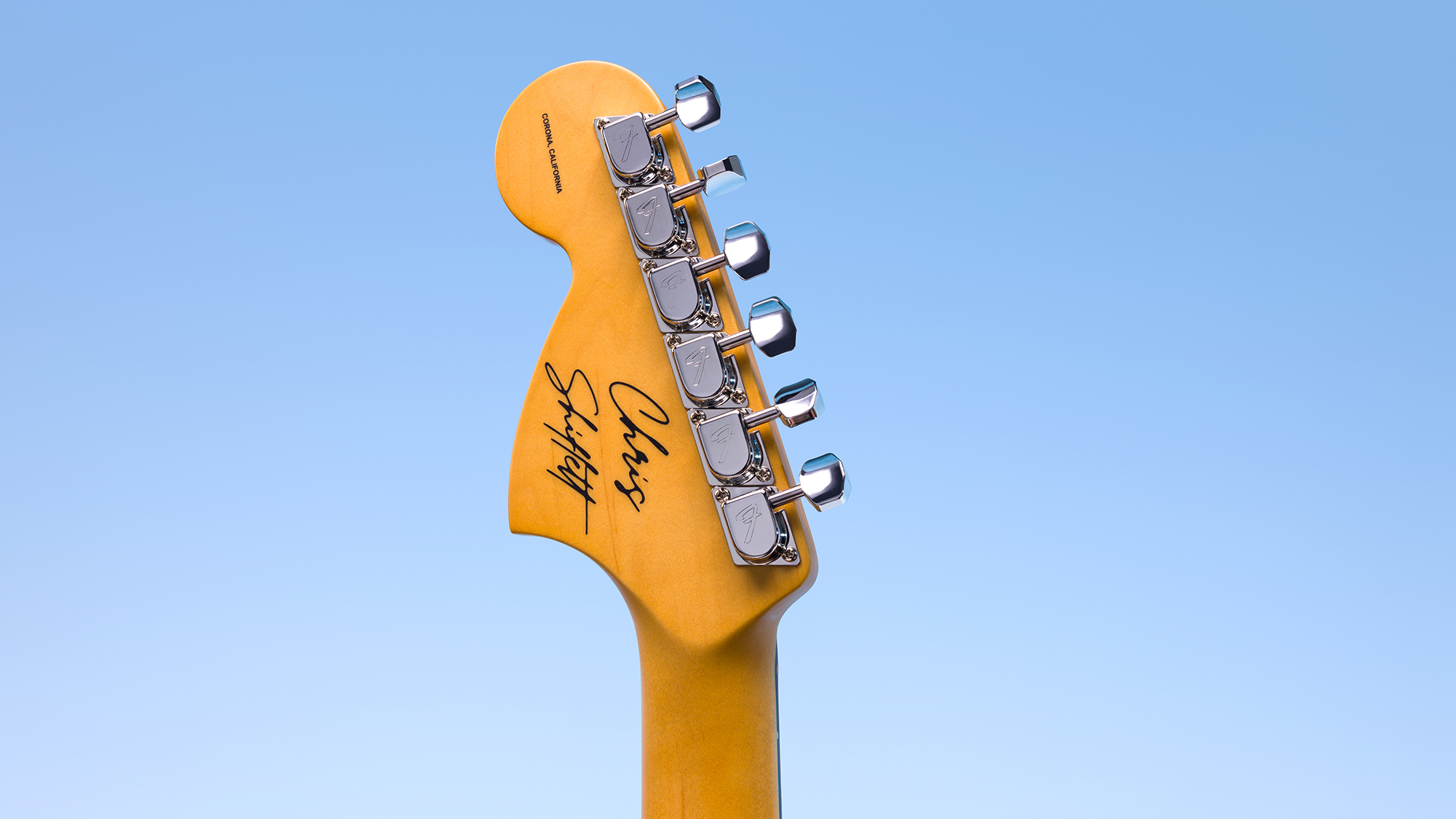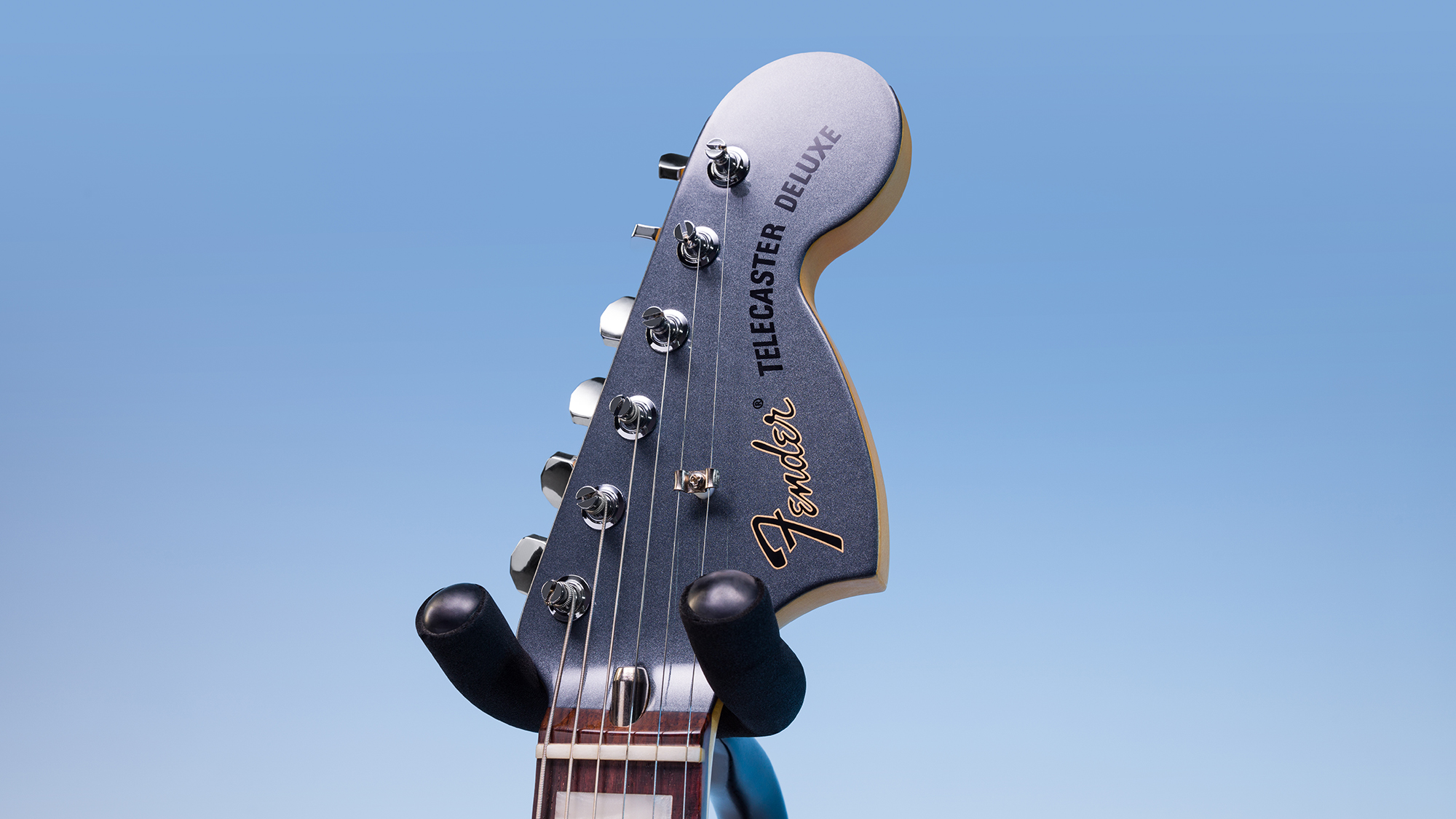
“When you have a new guitar in your hands, it makes you feel good. When you’re playing and messing around with sounds that are inspiring, that’s when the ideas come.”
That’s Chris Shiflett – veteran Foo Fighter, thriving solo artist and Shred With Shifty podcast host – waxing lyrical about his all-new, American-made Fender signature model.
It’s a rollout he’s been teasing since early spring, when prototype versions started appearing on his social media and onstage with him at Foos shows in the US. Now, road tested to perfection and ready to hit guitar stores, meet the Fender Chris Shiflett Cleaver Telecaster Deluxe.
Available in Dakota Red or Charcoal Frost, it comes loaded with two Custom Chris Shiflett Cleaver Noiseless CS-90 pickups and features a resonant alder body with a comfortable belly cut. It boasts a large, ‘70s Strat-style headstock, a speedy 25.5” scale maple neck with a 12” radius rosewood fingerboard and 21 medium jumbo frets.
It promises gutsy stadium-sized tones as well as the twangy cleans that you’re much more likely to find in Shiflett’s countrified solo sets.
It’s not his first rodeo with Fender signatures – in 2012 he teamed up with the company to launch a wallet-friendly Mexican Tele Deluxe, before going full bells and whistles on a more exclusive Masterbuilt variant in 2019.
Dubbed “The Cleaver” for its ability to slash through the mix – thanks to a pair of high-end Fralin P-90s – the Masterbuilt has been one of his main weapons of choice ever since. But he admits it was “crazy expensive” to make, and not suited to any kind of mainstream rollout.
Thus, the new Cleaver Deluxe was conceived to bridge the gap between the two previous models in terms of spec and price point.

Before we get onto the new Cleaver Deluxe, what do Telecasters mean to you, and what are your most enduring associations with them?
“Going way back, Keith Richards is probably the first person I associated with the Telecaster. Then Joe Strummer, of course, is a huge one. Then you get into all the country pickers. The Telecaster is so closely associated with country music – it's the gold standard of honky-tonk guitar playing.
Foo Fighters have a lot of sound coming off the stage and it’s something I’m always thinking about
“I think of it as the perfect workhorse guitar. You can’t really break them. You can drop them or kick them and they just keep coming back for more!”
What sets this signature model apart?
“The pickups. The original production model had humbuckers. This one has Fender pickups that are modeled after the Lindy Fralin noiseless P-90s I have in the Masterbuilt one.

“When I got the first prototype from Fender, I A/B’d it with my Masterbuilt and – to my ears – it sounded literally the same. I think they got that right on the very first pass.”
What other design elements were you most specific about wanting to include?
“I’m always excited by new colors. This comes in Dakota Red, like the Masterbuilt, but we’ve also got it in Charcoal Frost, which is super cool. I love that we painted the headstock. As an aesthetic detail that just appeals to me.
“All the details are spot on. The tint on the neck, the rosewood fretboard, the 500k pots. Those little details make a big difference to me going out on stage and playing all the time. This thing’s great out of the box and there’s no tweaking necessary.”
How did the guitar got its name?
“I think it was my old guitar tech, Sean Cox, or maybe our sound guy. I don’t remember who came up with it, but we called the original one ‘The Cleaver’ because it cut through!

In Foo Fighters we have a lot of sound coming off the stage and as one of the guitar players in the band it’s something I’m always thinking about. Where should my tone sit? The P-90s just have that growl.”
You’ve been using Superstrats onstage as well lately, which feel like the antithesis of the Cleaver Deluxe – or any Telecaster for that matter. So where does the love of shred guitars come from?
“You’re totally right! I’ve gotten a few of those over the years. When I grew up it was the era of Eddie Van Halen, Randy Rhoads, Yngwie Malmsteen and all those full-ripping guitar heroes. But I could never play like that! By the time I was playing in high school bands I’d moved into a different space musically.
It’s cool to let go of those silly rules we put on ourselves when we’re young
“There was a time you wouldn’t have touched a Superstrat, at least in my world – that was very illegal. It’s cool to be able to let go of those old feelings and those silly rules we put on ourselves when we’re young.
“The nice folks at Fender have given me one of those yellow and black Eddie Van Halen Strats. I’ve got a Charvel. I’ve got a regular Strat with a humbucker and a Floyd Rose in it. I’ll go to those occasionally for certain things.”

What other gear is most essential to you right now?
“For my solo stuff I’ve been using a Quad Cortex. For my podcast, I use the Tone Master Pro that Fender put out. It sounds amazing and it’s super intuitive. I like it a lot and I like messing with all that stuff.
“In Foo Fighters I have my real amps, but I also have the luxury of a giant road crew that sets all that stuff up for me. When it’s me on my own on a van tour, I’ll just take the Quad Cortex because it’s so much easier.
“They’re all just tools to get the job done. I think people get really worked up about new technologies, when it’s all just about whatever sounds good in the room.?
Has the experience of interviewing guitar superstars on your Shred with Shifty podcast impacted your approach to playing?
“It has – a lot! The premise of the show is that we’re breaking down one of my guest’s guitar solos. In advance of every interview I have to spend some time trying to figure out how to play the solo.

“First off, a lot of them are just hard and I can’t play them! But even the ones that aren’t as advanced technique-wise, it’s an interesting challenge to try to put somebody else’s phrasing in my hands.
“As guitar players, we’re all kind of doing the same stuff. It’s just our individual feels, where you start the lick; all that kind of stuff that makes your personal style.
“Over the course of a couple of seasons – and we’ve got most of season two in the can now – the idea has been that there’s so much information out there on how to play anything, but it’s almost always wrong!
“The mission was, ‘Let’s go to the source and find out exactly what was played.’ But you do that, and you realize they don’t know! They played it on a record at one point and they don’t remember it exactly.

“The biggest takeaway is that it doesn’t matter; that’s not the point of playing guitar. It’s not about learning anything exactly; but I love putting myself in somebody else’s mindset to try to understand what they did.”
What’s the most valuable thing you’ve learned from a guest?
“I interviewed Wolfie Van Halen, and even though I didn’t fully learn the tapping pattern of the solo we focused on, that definitely inspired me to learn the little tapping bit in Eruption to the best of my ability, and start throwing that into some Foo Fighters sets.”
All of a sudden you’re standing next to Brian May and you’re like, ‘That sounds like Brian May!’
What guests do you have lined up for season two?
“We’ve got Michael Schenker, Keith Urban, Molly Tuttle, Derek Trucks and a bunch more after that. I interviewed Zakk Wylde just the other day. So there’s some really good guitar players in this season.”
As somebody who’s also shared stages with a lot of legendary players over the years, who has been the most memorable?
“Brian May would be a big one – that was when I first joined Foo Fighters and we played at Brixton Academy. Brian came out and played a song with us. All of a sudden you’re standing next to that dude and you’re like, ‘It’s Brian May! That sounds like Brian May!’

“I love when you play with some of these folks and it reminds you of how much of it’s in the hands. It’s who they are; it’s how they play and it’s that tone.”
Is it difficult to focus on what you’re doing when you’re standing next to people like that?
“Absolutely! When we played at the Rock and Roll Hall of Fame, Paul McCartney came out and we did a song with him. I remember really specifically prepping myself to stay in the moment, look around, breathe deep, take it all in, look at your bandmates, look at Paul McCartney, look at your family right over there.
“And of course, when you start doing that, you start playing the song wrong. So there you go!”
- The Chris Shiflett Cleaver Telecaster Deluxe will retail at $2,499.99 USD / £2,599 GBP / €2,999.







